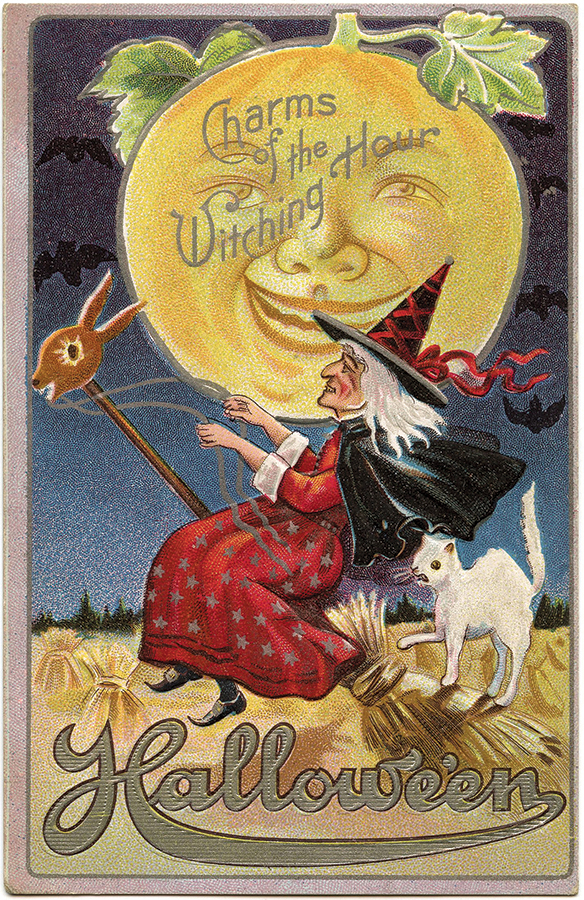The Mystical Witches of Clappertown

Un texte de Heather Darch
Paru dans le numéro Automne/Fall 2022
Publié le : 8 août 2022
Dernière mise à jour : 11 août 2022
Fables about witches have fascinated and frightened humanity for centuries all around the world and even in Clappertown, Quebec.
Long before Mystic, Quebec got its magical name, the community was called Clappertown. The hamlet was settled by the Dutch-speaking Clapper family. Loyalists from New York, Adam Clapper Sr., along with his brothers Hendrich and Lambert and his son Adam Jr., appear in Stanbridge Township land records in 1796. Along with their wives and worldly possessions, they also brought their superstitions.
The Clappers understood that witches were as much a reality as bears and wolves in their new home. They believed a rocky elevation on their property they named “Witch Hill,” was where witches met at midnight to select the seventh son of the seventh son and pull him through a keyhole. This luckless fellow was ridden like a horse into the night, hitched to a post until nefarious revelries and witchy incantations were completed and then cantered back home before dawn.
Fables And Legends
“Seventh son” lore stems from ancient Irish legends, but it can be found in many versions of “witch tales.” In some stories, the ill-fated male is the victim of witches but in others, he is enchanted with the power to foretell the future and restore health.
Fables about witches have fascinated and frightened humanity for centuries. One of the earliest written records of a witch is the Old Testament’s “Witch of Endor.” Twelfth century Arthurian legends identify Morgana as a witch with wicked ambitions. Macbeth meets the three witches on the heath in 1606 and in this story, as in most accounts, witches are a synonym for evil. Those accused of witchcraft were mostly single and elderly women or people on the margins of society.
The Age Of Witchcraft
Seeing a proliferation of witches marked the 17th century in particular as the “age of witchcraft.” England’s Lord Chief Justice noted in 1602 that: “The land is full of witches… they abound in all places” – not as a symbol or figure of fun, but as a deadly threat to life, livelihood and divine order.” In pre-scientific societies, witchcraft made perfect sense. In times of famine, inexplicable misfortunes, plague and religious upheaval, society turned to the supernatural when “the world had got so foul that it was coming to an end.”
Witchcraft was closely connected to the print revolution. With the 1487 best-seller Malleus Maleficarum, a “how-to” on dealing with witches, starting the trend. It recommended hanging or burning witches alive. Similarly, The Wonderfull Discoverie of Witches in the Countie of Lancaster, sensationalized the Pendle Witch Trials of 1612; underscoring witch-mania for years.
Witch Trials
The same hysteria happened in the New World too. Heightened religious extremism in Connecticut meant that Alyse Young was the first person in North America executed for witchcraft in 1647. The best-known witch trials took place in Salem, Massachusetts in 1692. 150 people were accused and 18 were put to death, including six men.
In the 1660s, New France could be a frightening place. Its citizens lived a precarious existence in the extremes of Quebec’s landscape and weather. An earthquake in 1663 created great anxiety. Around the same time, the Ursuline nun Marie de l’Incarnation caused distress when she wrote of the discovery of “sorcerers and magicians in this country.” In stark contrast to what was happening in the Colonies, witchcraft trials were rare. And no one was ever put to death. It probably helped that the royal adjudicators were often anticlerical.
In The Eastern Townships
By the 19th century, witches were recognized as superstitious imaginings, but people still continued to harbour a fear of them. The tale of Peggy Green in the Eastern Townships’ Compton County, occurs very late in “witch history.” She was accused (after her death in the 1880s) of being a shapeshifter. It was said she who could transform herself into a white hare that suckled cows dry. Dismayed as to why their cows stopped producing milk, farmers set a trap and caught the hare. Before releasing it, they notched its ears. When Peggy died it was observed at her funeral that her ears were notched. In Celtic mythology, the hare-as-witch is a common theme.
Back in Clappertown, witches were present if a cow’s udder was infected. If cream wouldn’t churn or if a hunter missed his quarry. Fortunately, there were remedies. Like rubbing the udder with a petticoat, plunging a red-hot horseshoe into the cream and placing a gun into a stream to “drown out the witch.” The old witches of Clappertown are still waiting on “Witch Hill,” watching for the seventh son of the seventh son so, beware!
Heather Darch
Sources:
Erastus Chandler, “Poems and Essays,” 1877; “Clappertown: As it was and as it is; An historical sketch,” http://sites.rootsweb.com/~qceastwn/archives/Clappertown001.htm; Julia Bugeia and Theodora Cornell Moore, “Academy Days in Old Missisquoi,” 1910; Suzannah Lipscomb, A very brief history of witches https://www.historyextra.com/period/tudor/history-witches-facts-burned-hanged/; H.E. Howes, The Legends of King Arthur https://www.bl.uk/medieval-literature/articles/the-legends-of-king-arthur; History of Witches https://www.history.com/topics/folklore/history-of-witches; Susan Moulton, Witchcraft : creation of the “evil other.” http://orias.berkeley.edu/sites/default/files/2011-moulton-ppt.pdf; The Bible (1 Samuel 28: 3-25 written between 931 B.C. and 721 B.C.); Demonology: The Malleus Maleficarum(The Hammer of Witches),Proliferating Witch Hysteria https://www.mtholyoke.edu/courses/rschwart/hist257/stephwhit/final/malleus.html; Witches and Witchcraft: The First Person Executed in the Colonies, https://www.jud.ct.gov/lawlib/history/witches.htm;
Salem Witch Trials, https://www.history.com/topics/colonial-america/salem-witch-trials; Alastair Sooke, Where do witches come from? https://www.bbc.com/culture/article/20140925-where-do-witches-come-from; André Pelchat, Sorcery in New France, December 2015-January 2016 issue of Canada’s History magazinehttps://www.canadashistory.ca/explore/french-canada/sorcery-in-new-france; John Kalbfleisch, Second Draft: New France didn’t share New England’s hysteria about ‘witches’ https://montrealgazette.com/opinion/columnists/second-draft-new-france-didnt-share-new-englands-hysteria-about-witches; Grant Myers, “The Witch of New Mexico Road: Irish Folklore in the Eastern Townships.” Quebec Heritage News, Winter 2019 http://qahn.org/files/quebecanglophoneheritagenetwork/documents/qhn_winter_2019.mf_layout_1.pdf.

